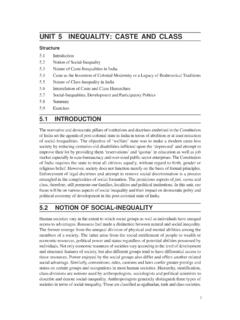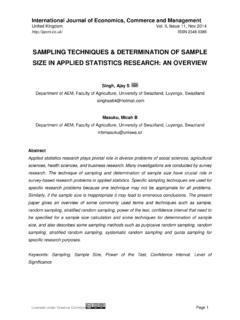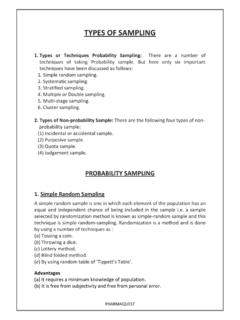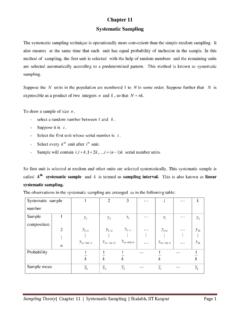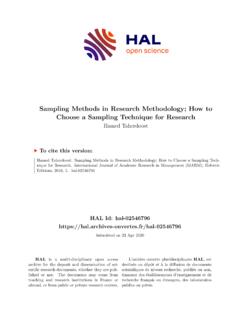Transcription of Probability and Non-probability sampling
1 Probability and Non-probability sampling There are certain issues to be taken into consideration while deciding to use Probability or non Probability samples. Some research studies are not designed to be generalized to the population but collect exploratory data for designing questionnaires or measurement instruments. A non Probability sample is appropriate in these situations. Secondly, if the cost of a Probability sample is too high in relation to the type and quality of information collected, then a non Probability sample is a possible alternative.
2 Since, Probability samples are often time consuming, a non Probability sample may be adopted to meet the time-constraints. Although Non-probability may be appropriate in certain situations, it is always best to use a Probability sample when a study is conducted to support or refute a significant research question or hypothesis and the results will be generalised to the population. We take up these two designs separately: Non-probability sampling : In this type of sampling the items for the sample are selected deliberately by the researcher.
3 In other words, the researcher purposively chooses particular units of the universe for constituting a sample. Mass media researchers frequently use Non-probability sampling , particularly in the form of available samples, samples using volunteer subjects and purposive samples. Some of the different types of non Probability samples are: a) Accidental samples b) Available/Convenience samples c) Volunteer samples d) Purposive samples e) Quota samples Accidental samples: In accidental sampling , the researcher simply reaches out and selects the subjects that he comes across and continues doing so till such time as the sample reaches a designated size.
4 For example, he may take the first 150 persons he meets at a mall entry point who are willing to be interviewed or to provide the information he is seeking. In such a sample, there is no way of estimating bias except by doing a parallel study with a Probability sample or undertaking a complete census. This does not mean that accidental samples have no place in scientific research. Besides being economical and convenient, they can provide a basis for stimulating insights and hypotheses. Available samples: An available sample is also known as a convenience sample.
5 It is a collection of readily accessible subjects for study, such as a group of students enrolled in a mass media course or shopkeepers in a mall. Although available samples are helpful in collecting exploratory information, the samples may contain unknown quantities of error. Researchers need to consider both the positive and negative aspects of available samples before using them in a research study. Available samples are a subject of debate in research. Critics argue that available samples do not represent the population and therefore have no external validity.
6 Proponents of available samples claim that if a particular trait or characteristic does exist, then it should exist in any sample. Available samples can be useful in pretesting questionnaires or conducting a pilot study. Volunteer samples: Persons who willingly participate in research projects are known as volunteer samples. Subjects who constitute a volunteer sample also form a non Probability sample as the individuals are not selected according to mathematical guidelines. Researchers have found that volunteer subjects tend to exhibit higher educational levels, occupational status and intelligence levels.
7 These characteristics imply that the use of volunteer subjects may significantly bias the results of the research and may lead to inaccurate assumptions of various population parameters. In some cases volunteer subjects are necessary but they should be used carefully since they contain unknown quantity of error. Volunteer samples are extensively used these days by the media and internet websites. Various polls conducted on radio and television stations, TV networks, the Internet, newspapers and magazines use volunteer samples.
8 However, volunteer samples are shown to be inappropriate in scientific research. Purposive samples: The basic assumption behind purposive sampling is that the subjects are selected for a specific characteristic or quality and eliminates those who fail to meet these criteria. Purposive samples are often used in advertising studies where researchers select subjects who use a particular type of product and ask them to compare with a new product. However, in such a sampling there is no assurance that every element or subject has some specifiable chance of being selected.
9 Here, the sampling errors and biases cannot be computed since the sampling procedure does not involve Probability sampling at any stage. Quota samples: One of the most commonly used methods of sampling in market research is the method of quota sampling . Here the subjects are selected to meet a predetermined or known percentage. The basic objective of quota sampling is the selection of a sample that is similar to the population in terms of proportion of certain characteristics. For example, a researcher is interested in finding out how girl students differ from boys in their intelligence levels in a co-educational institution.
10 And, there is a sharp difference in the proportion of girls and boys studying in the institution, then, a quota sample is appropriate in order to reflect the population characteristics. In quota sampling the population is reflected in terms of certain characteristics and the proportion of the population with specific characteristics is determined and selected like-wise. Probability sampling : This type of sampling corporate a systematic selection procedure to ensure that each unit has an equal chance of being selected.
